|
Southern Pakistan
  On
arrival at the border town of Taftan in Pakistan, two things stuck
out:the locals take great pride in their trucks and a wide open hot
windy bust bowl. The only tar road between Taftan and Quetta, 640
kilometres of it and really only room for one car at a time. Passing
and overtaking cars, let alone trucks, is a mission to say the least! On
arrival at the border town of Taftan in Pakistan, two things stuck
out:the locals take great pride in their trucks and a wide open hot
windy bust bowl. The only tar road between Taftan and Quetta, 640
kilometres of it and really only room for one car at a time. Passing
and overtaking cars, let alone trucks, is a mission to say the least!
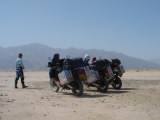 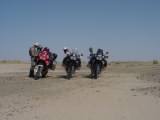 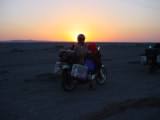 Southern
Pakistan
is mainly desert and very hot, hence the early morning starts. Southern
Pakistan
is mainly desert and very hot, hence the early morning starts.
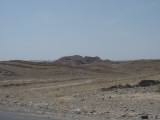 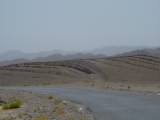 The
usual terrain: vast, barren desert. A big
bonus was having fitted 43 litre fuel tanks. Fuel stations were not
often seen. The
usual terrain: vast, barren desert. A big
bonus was having fitted 43 litre fuel tanks. Fuel stations were not
often seen.
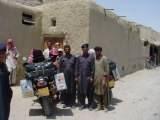 Close to the Afghan border and due to the heightened security from
September 11, we were required to stop and sign the registers
at many police check points such as this one. The usual
interested locals looking at the bikes at Panjpai on the road to D I Khan.
Close to the Afghan border and due to the heightened security from
September 11, we were required to stop and sign the registers
at many police check points such as this one. The usual
interested locals looking at the bikes at Panjpai on the road to D I Khan.
Quetta
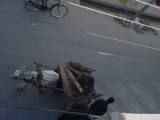 The
view from our hotel in Quetta. Here a donkey cart goes about his daily
business. The
view from our hotel in Quetta. Here a donkey cart goes about his daily
business.

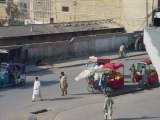
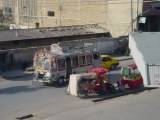
Downtown
Quetta from our hotel roof. Although this town is a dirty, smelly place,
it has the feel of life to it. There are many locals bustling about
their daily activities at most times of the day or night. Whether they
are rickshaw/taxi drivers or selling fruit, everyone seems to be busy
as a bee.
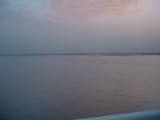 This is
the mighty Indus river, the biggest river in Pakistan. It starts high
up in the Himalayas and runs down south gaining momentum and size all
the way down to the sea at Karachi. Here we cross it at D I Khan
where it is only about half its eventual size.
This is
the mighty Indus river, the biggest river in Pakistan. It starts high
up in the Himalayas and runs down south gaining momentum and size all
the way down to the sea at Karachi. Here we cross it at D I Khan
where it is only about half its eventual size.
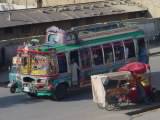 Not only
are the trucks colorfully painted and decorated, but the busses too.
Here a "normal" looking bus makes its way through the crowded
streets of Quetta.
Not only
are the trucks colorfully painted and decorated, but the busses too.
Here a "normal" looking bus makes its way through the crowded
streets of Quetta.
The nightmare
"road" from Quetta (along Afghanistan border) to D I Khan
Crossing
the rivers was no easy task.
It's
a waiting game for the rivers to subside so that we can cross them.
These are flash floods and don't last that long. A 30 minute wait and the
river is half the depth it was. Some of the cars take the plunge but
the choice is where to cross...?
Gary, patiently
makes his way across making sure to keep his feet wide in case of unseen
rocks which could throw the bike to one side.
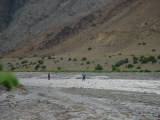 The river
bed surveyors hard at work, a foot deep in the muddy water. It's best
to walk the route you wish to ride first to move any rocks which could
make the
The river
bed surveyors hard at work, a foot deep in the muddy water. It's best
to walk the route you wish to ride first to move any rocks which could
make the
crossing difficult. One fall in this water could mean hours of work
on the bike should it take on water. Another point to remember is the equipment
we are carrying i.e.. computer, camera, batteries, etc.
The
bikes, all kitted out and nowhere for them to go! This was the last crossing, or not, before making camp. We decided
against crossing as it was quite deep and we would only have to cross
it again as the river wound its way down the valley.
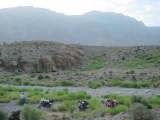
As we had
been stopping constantly all day for the rivers, we ran out of light and
so had to make camp close to one of the rivers. This is quite hostile
country, not far from the Afghanistan border. We ducked in behind some
grass patches and made camp. We keep a emergency supply of pasta and
tuna for such occasions and they always seem to come in handy!
Dom, navigator
and leader of the group, has to pick all the difficult routes
though rocks, mud, etc. and it's easy for the others to follow. However,
some places are not easy to pass. Although they appear to be ok
at a glance, they'll either subside (rocks) or sink in (mud) when you
put a 300kg bike on them! Dom crossed an average looking mud spot and,
as the back wheel drifted across to the left, the right pannier, quite
low to the ground, dug into the mud. He was going at about 20 kph so
as the bike came to a sudden halt, he was thrown through the front screen
and the pannier stayed in the mud, being cleanly removed from the bike!
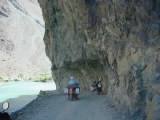 This is
the wonderful road that greeted us after the rough camping in Taliban
country. The river had subsided overnight and, although we had to cross
it 3 times, it was worth the effort to ride along the
beautiful valley that the river created. This is
the wonderful road that greeted us after the rough camping in Taliban
country. The river had subsided overnight and, although we had to cross
it 3 times, it was worth the effort to ride along the
beautiful valley that the river created.
The Karakoram Highway - on the
Karakoram range -
2nd largest mountain range only to the Himalayas.
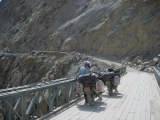 The
road from Chitral to Gilgit had some wonderful river crossings over
home made bridges. There is not much traffic along this route so we
not too sure how stable these were but they all passed with flying
colours! The
road from Chitral to Gilgit had some wonderful river crossings over
home made bridges. There is not much traffic along this route so we
not too sure how stable these were but they all passed with flying
colours!
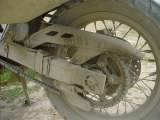 The bikes
certainly had their work cut out on the offroad section from Chitral
to Gilgit! Here Maggie, Doms bike, shows the after effects of the conditions,
she needs a good wash!
The bikes
certainly had their work cut out on the offroad section from Chitral
to Gilgit! Here Maggie, Doms bike, shows the after effects of the conditions,
she needs a good wash!
 And a puncture!
And a puncture!
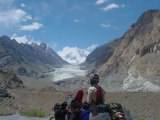 The
Shisper glacier The
Shisper glacier
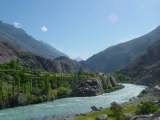 Ghizar Valley
Ghizar Valley
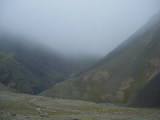 The source
of the Indus River
The source
of the Indus River
Some
beautiful scenes of the Karakoram Highway
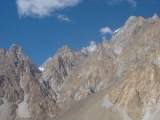
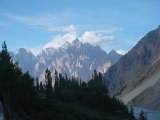
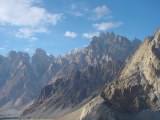
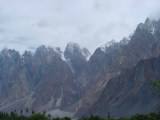
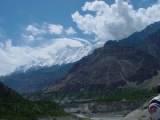
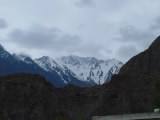
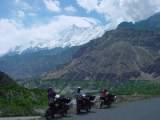
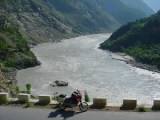
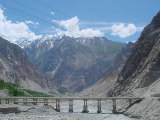


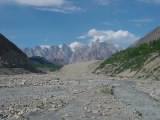
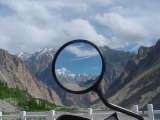
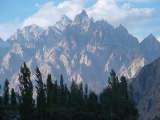
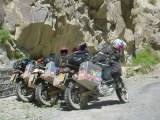
Shandur
Pass

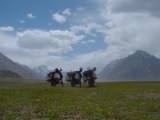
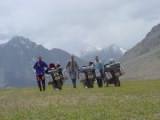
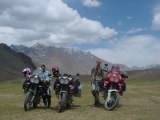
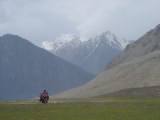
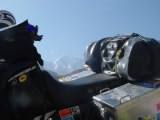 Buni Zom
Buni Zom
Sometimes
we had to be patient for the roads to be repaired before we could
continue.
Pakistan
- China border
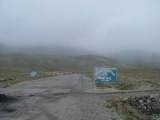
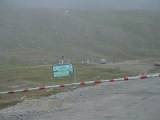
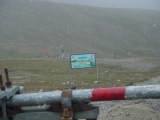
Passu
Glacier
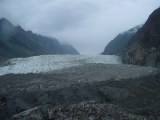
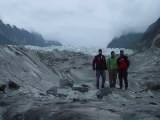


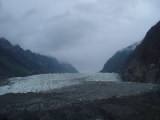
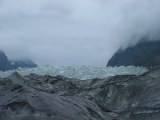
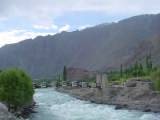
Rakaposhi
Dwarfed by this
7800 metre, snow-capped giant.
Gilgit
The Indus gains
momentum and we hitch a ride on the local transport in Gilgit!
Dom
found his Ohlins shock to be leaking so it had to be stripped out for
inspection. Sultan, our friendly host for the past 2 nights, offers a helping hand.
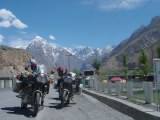 Shisper, the last town in Pakistan before the Chinese border. We were
unfortunate not to find fuel here and so, had to return 100 kilometres
back to Hunza, where we were very fortunate to get the last of the areas
fuel!
Shisper, the last town in Pakistan before the Chinese border. We were
unfortunate not to find fuel here and so, had to return 100 kilometres
back to Hunza, where we were very fortunate to get the last of the areas
fuel!
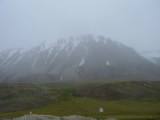 Eventually,
the top! It
was freezing at the top of the Khunjerab pass (Chinese border). We did
not stay long here as, at 4200m, temperatures are below 0! We had
donned our full winter gear of Goretex jackets, winter gloves and neck
warmers in order to stay relatively warm, some equipment we hadn't seen
since Europe! Eventually,
the top! It
was freezing at the top of the Khunjerab pass (Chinese border). We did
not stay long here as, at 4200m, temperatures are below 0! We had
donned our full winter gear of Goretex jackets, winter gloves and neck
warmers in order to stay relatively warm, some equipment we hadn't seen
since Europe!
|

